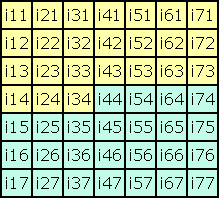A magic square s is self-complementary if there exists a general square-transformation T (i.e. rotation or reflection)
with C·T(s) = s.
Where C is the complementary-transformation, that changes the numbers of an order-7 square in the following way:
C:n(x,y)-->50-n(x,y) with natural numbers, or C:i(x,y)-->-i(x,y) with integers.
|
If the order of the square is odd, T has to be the 180°-rotation: T:i(x,y)-->i(8-x,8-y)
Proof: All axis reflections have 7 fixed cells that are in a row, a column or a main diagonal.
But as C has only one fixed point, namely cell (4,4), C·T could not be the identical transformation.
|
We get C·T:i(x,y)-->-i(8-x,8-y) and as we consider self-complementary squares C·T:i(x,y)-->i(x,y).
==> i(x,y)=-i(8-x,8-y)
Let us use the shortform ixy for the integer i(x,y). We get 25 equations:
|

|
i15=-i73, i25=-i63, i35=-i53,
i16=-i72, i26=-i62, i36=-i52,
i17=-i71, i27=-i61, i37=-i51,
|
i44=-i44, i54=-i34, i67=-i21, i74=-i14
i45=-i43, i55=-i33, i65=-i23, i75=-i13
i46=-i42, i56=-i32, i66=-i22, i76=-i12
i47=-i41, i57=-i31, i67=-i21, i77=-i11
|
The equation i44=-i44 is only fulfilled by i44=0.
If you know the 21 numbers of the first three rows and the first 3 numbers of the fourth row, you know the whole square.
Thus we have to consider only 24 variables, the yellow part of the square.
|
|
Notice that we got an homogeneous equation system with 12 equations and 24 variables.
Investigations show that the system is linearly independent,
i.e. no equation is a linear combination of the others. |
|
The following equations are linear combinations of the 12 fundamental equations A, B, ... K.
But as these new equations contain only 6 variables they are very useful for the calculation of squares. |
(M) i21+i41+i61+i32+i52+i43 = 0 <=> ( 3(A+G+J) +2(B+I+L) +1(C-H-K) ) / 7
(N) i41+i32+i42+i52-i13-i73 = 0 <=> ( 1(A+G+J) +3(B+I+L) -2(C-H-K) ) / 7
(O) i21+i61+i13+i43+i73-i42 = 0 <=> ( 2(A+G+J) -1(B+I+L) +3(C-H-K) ) / 7
|
(M)  |
(N)  |
(O)  |
(P) i11+i21+i31+i12+i22+i13 = 0 <=> ( 3(A+D-L) +2(B+E-K) +1(C+F-J) ) / 7
(Q) i21+i12+i22+i52-i33-i63 = 0 <=> ( 1(A+D-L) +3(B+E-K) -2(C+F-J) ) / 7
(R) i11+i31+i13+i33+i63-i52 = 0 <=> ( 2(A+D-L) -1(B+E-K) +3(C+F-J) ) / 7
|
(P)  |
(Q)  |
(R)  |
|
You can easily generate more equations by rotating the squares.
Thus you get 24 such equations.
They were all generated by applying special transpositions with equation (M). |


















